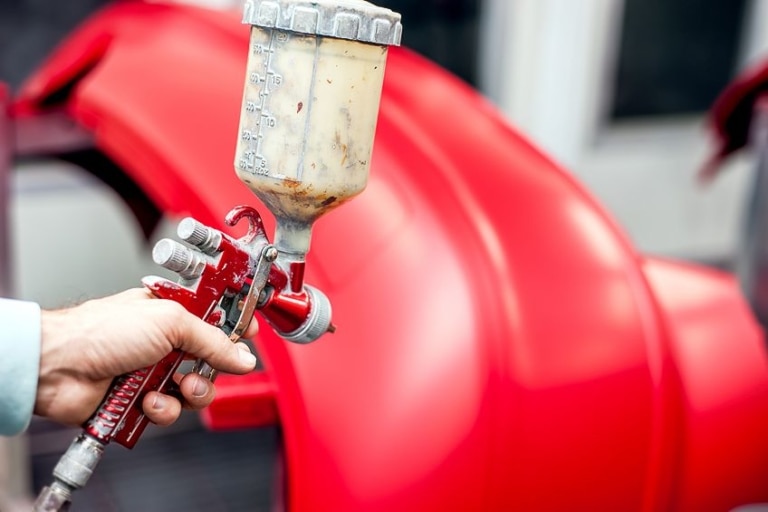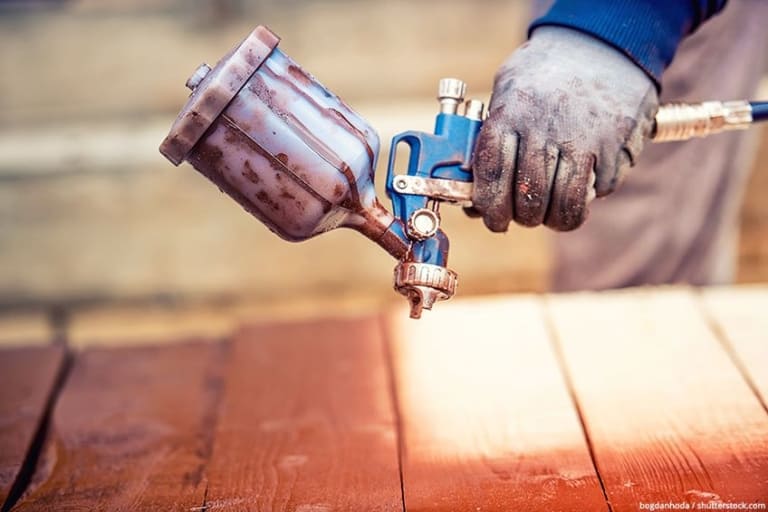Can You Spray Paint Glass? – A Guide on How to Spray Paint Glass
Disclosure: There are some affiliate links below and I may receive commissions for purchases made through links in this post, at now additional cost for you.
Spray painting can be a challenging task, especially for beginners. Between gaining confidence and developing your technique, it can be easy to forget that certain materials need certain types of paints and preparation techniques to be coated. Glass is one of the materials we tend to take for granted the most, and is not something most people think about painting, so how do you go about putting spray paint on glass? Can you spray paint glass? Let’s find out.
Table of Contents
What Kind of Spray Paint Works on Glass?
You are forgiven if your thought process led you to believe that any type of paint works on glass. After all, glass is typically clear in our everyday lives, although there are instances such as crafting and window stains that require glass to be coated in paint. Below is a table detailing paints that work on glass and the visual effect they produce once applied.
| Type of Paint | Appearance/Effect on Glass Surfaces |
| Enamel Paints (oil-based and other) | Gloss, opaque, clear, smooth, resistant to scratches |
| Acrylic Paints (clear and color) | Clear, transparent, stained glass effect, resistance to scratches and friction |
| Oil Paints | Smooth, intense color, waterproof, sheen finish |
| Solvent-Based Paints | Smooth, muted color, smooth texture, protects against minor scratches and UV damage |
Best Spray Paint For Glass: Krylon Looking Glass Silver-Like Aerosol Spray Paint
Before you can learn how to spray paint glass, you will need to know what the best tool for the job is. In our opinion, you should look no further than Krylon’s aerosol spray paint. One of the most recommended and easily recognized aerosol sprays on the market, Krylon has made a name for itself by being one of the most high-quality paints available today, with finishes that change the perception of the surfaces they are applied to. Krylon is one of the more versatile brands on the market, and although this particular product is specially formulated to work on glass specifically, there are also multipurpose products on the market that can be used on metals, ceramics, and plastics alike.
- Provides a decorative, durable finish on glass surfaces
- One step, easy to use, and dries to the touch in 5 minutes
- Spray on reverse side of clear glass for a reflective finish
Krylon’s glass silver spray paint will give you the ability to confidently paint glass with the peace of mind that you will be able to apply your next coat in only five minutes after your first coat has been applied. This is especially useful when time is at a premium, which makes it no surprise that many professional spray painters choose Krylon when they need to paint glass. The paint will provide you with a durable sheen-like finish and is extremely easy to use. Simply follow the directions on the can and find your groove while spraying, and before you know it your next masterpiece will be complete!
PROS
- Easy to use
- Inexpensive
- Premium feel
- High-quality finish
- Versatile brand
- Reputable brand name
CONS
- Limited capacity
- Can only be used on glass
- Not for large workpieces
Do You Need a Primer When Applying Paint to Glass?
Spray paint on glass tends to work well enough, although if you are looking for a much smoother overall look and texture, using a primer is recommended. However, this does not mean that applying primer when using spray paint for glass is always necessary.
Whether you are using spray paint in the form of a can or using store-bought paint in a powered paint sprayer, these paints are typically effective on glass if the surface has been prepared adequately.
This does not necessarily mean that any paint that you use on glass surfaces will have the desired effect, it just so happens that most paints sold in cans or for use in paint sprayers are oil- or acrylic-based, which makes them conducive for coating glass surfaces.

Using a primer when applying spray paint for glass will help it adhere to the surface a lot easier, assuming that the glass has been adequately prepared. Unfortunately, glass is what is termed as a “sheer” surface, which means that it is very difficult to produce any kind of surface friction for coatings to stick to it. This is in stark contrast to surfaces like wood, metal, and ceramics.
This being said, you should take special care in the preparation process when applying spray paint to glass surfaces.
If you are looking for a good primer for your glass workpieces, we recommend Kilz Adhesion multipurpose primer. Designed and produced to work on irregular/sheer surfaces, Kilz is one of the best primers on the market. Whether you are working on large glass workpieces or simply like having some glass primer around just in case, Kilz has your back.
How To Spray Paint Glass Effectively
Whether this is your first time attempting to paint glass or you are just looking for some tips to improve your technique, here is a step-by-step guide on how to both prepare your glass workpiece to receive paint and how to most effectively apply said paint with minimal errors, splatters, repeat attempts or (in the worst-case scenario) breakage.
Ensure That Your Glass Is Clean
As we covered previously, glass is a sheer surface designed and used specifically so that things don’t stick to it. Think about the windows in your house or the windshield of your car – water, and other viscous substances run right off them, and although there are liquids that have an easier time sticking to them, they are easily removed. This being said, washing your glass workpiece with some soapy water and removing small pieces of debris, dust, and scratches that have been filled with grime is the first step in the preparation process and should be done thoroughly. Allow time for the glass to dry completely.
Cover Contact Surfaces
Glass is one of the most common materials we use for containers in our homes, which means that our hands and mouths come in contact with these surfaces multiple times on a daily basis. Therefore, it is of critical importance that you cover or tape up areas on glass workpieces that will come in contact with any sensitive areas on your body.
A common example of this would be the rim of a drinking glass. Simply use some tape and apply it strategically in order to avoid primer or paint coming in contact with your mouth in the future.
For good measure, you can also cover any surfaces that you will be in contact with while you are priming your workpiece to ensure that nothing gets on your hands should you need to manipulate the workpiece during the priming process.
Rub Down with Liquid Spirits
This is a bit of an old-school trick, but rubbing down your glass with some liquid spirits does help the adhesion process, especially if you are using oil-based paints. You can go about this either by be submerging the glass workpiece into a shallow container of liquid alcohol and rotating it or by applying some to a cloth and giving your workpiece a once-over.
When working with liquid alcohol, ensure that you are in a well-ventilated area, as liquid alcohol can cause you to become a bit disorientated when inhaled in large quantities. Once you have completed your coating, place your workpiece in direct sunlight while drying to ensure the complete evaporation of the spirits.

Apply Primer
We mentioned previously that using primer on glass is not entirely necessary, although should you have the option to do so, you should know that it will greatly improve the application process and will enhance the finish of the paint once dried.
Depending on what kind of paint you intend to use on your workpiece, your primer may be alcohol-based, which might seem redundant considering that the previous step suggests you use alcohol to prepare your surface, but this is just a coincidence. Before loading your primer into your paint sprayer or getting ready to spray with a spray can, always ensure that you follow the manufacturer’s instructions for preparation such as shaking or mixing the primer.
The technique you are aiming for is to apply very light and quick coats in an even, uninterrupted manner to the surface of the glass.
Glass primers dry pretty quickly, so work fast and ensure that you use gloves if you plan on rotating your workpiece, as the primer can be harmful to your skin. Your workpiece should be ready to receive paint about ten minutes after your primer dries.
Start Painting
Painting and priming go hand in hand, specifically when it comes to spray painting. The technique required to execute both tasks demands a steady hand, regardless of whether you are working with a powered sprayer or a can of spray paint. When spraying, you should aim to apply multiple light coats – the trick to doing this is good control of your trigger/nozzle finger and good distance management from your workpiece. Make even, smooth, uninterrupted passes over your workpiece until you achieve maximum coverage.
Once you have applied your first coat, inspect your workpiece while it dries for any spots you may have missed or overapplied. When working with glass, it is best to apply multiple coats – between three to four coats should be adequate depending on whether you would still like some light to be able to pass through the glass. You should allow three to four hours between coats to ensure that each layer dries adequately, and do not forget to remove any protective tape you may have used to cover areas where you handled the glass.
Apply Sealant
This step is not a must, considering that some paints don’t need to be sealed or you may just like the look and texture of your workpiece with just the paint. Should you be wondering how to seal spray paint on glass, you can simply purchase a glass sealer for various types of paint at most hardware stores and craft shops.
Applying sealer is not typically done with a paint sprayer and is more commonly done using the spray can (or quite a few cans for larger workpieces, as you can probably imagine) and applying it uniformly to the workpiece at a decent distance and allowing the sealant to dry as the manufacturer directs.
Sealants are typically sold for sealing acrylic paint being used on glass surfaces due to the texture produced when it is applied to the surface.
You can apply two to three coats and allow time for each coat to dry in-between, although the time can differ depending on the brand and type of sealant you used. Following these steps on how to seal spray paint on the glass will ensure that your glass workpiece maintains its finish for a long time.
If you happen to be looking for a good sealer for glass paints, you won’t be disappointed with Krylon’s Gallery Series. Sold in an 11 oz aerosol container, it is both easy to use and will provide you with a clear coat seal that protects your glass workpiece from UV damage and light scratches. Krylon is a reputable brand and reviewers can’t seem to get enough of it!
Tips and Tricks for Spray Painting Glass
Here are some helpful tips and tricks for spray painting glass. Although the process is pretty straightforward, understanding the finer details in preparation and technique is often what sets a good project and a great project apart. This being said, let us have a look at some habits you can develop to ensure that you maximize the visual appeal of your spray-painted glass workpieces.

Keep It Clean
Although we mentioned this in the tutorial, keeping your workpiece clean and ensuring that it stays clean until your primer is applied can save you a lot of time. Having to revisit, strip, and repaint a section of your workpiece because some pesky particles have caused your paint to rise from the glass is an awful experience. Always make 100 percent sure your workpiece is clean and smooth before applying primer and/or paint.
Keep It Light
This is a good tip for those of you who prefer not to use a primer. Painting conventional surfaces (which have some “grit”) means you don’t have to apply that many coats – this is mainly the case with wood. When working with glass, however, try to keep the coats light and compensate by repeating these light coats three to four times until you are satisfied with your coverage. This will also allow you to determine what level of transparency you want your glass to have if you have not yet decided.
Remember That This Is Still Painted Glass
Once you have completed your labor of love and stand back to marvel at your workpiece, it can be easy to forget that it is still just painted glass. Remember that unless the glass has been baked or stained with color, it will be chipped and scratched pretty easily, even if you used some of the paint types we mentioned above.
Therefore, if your glass pieces will be handled and/or moved frequently, you should consider one of the above coating methods to ensure the longevity of your workpiece. On this note, do not try to dishwash any glass pieces you have spray painted, as the paint will strip and you will have paint particles in your dishwasher.
So, does spray paint work on glass? Yes, and depending on your skill level, budget, and project scale, you can make amazing workpieces using spray paint on glass. Now that you know how to prepare glass for spray painting, what type of spray paints work on glass, what type of finishes they provide, and have an idea of what a good spray paint looks like, it is now time for you to get out there and make use of your newfound knowledge. Remember to always ensure that you wear the appropriate personal protective gear, and as always, safety first!
Frequently asked questions
Does Spray Paint Stick to Glass?
Does spray paint stick to glass? Spray paint does stick to glass easily, but to help the adhesion process a primer can be used to make sure that it stays stuck. A good way to protect your glass workpieces is to apply some sealer for acrylic glass paint.
Will Spray Paint Last on Glass?
Spray paint and glass are not exactly two peas in a pod. Because glass is a sheer surface and naturally has low surface friction, it is difficult for most substances to stick to it. You should not expect a lifespan of decades for glass that has been spray painted, but you should get a good couple of years out of your spray-painted glass workpiece before you start seeing any noticeable decay.
Can You Spray Paint Glass?
Yes, glass can be spray painted with most common oil and synthetic paints available on the market today, although the paints are only part of the job. The trick to spray painting glass and doing it well comes from the preparation of the glass to receive the spray paint. This being said, select the appropriate type of spray paint for your glass’s application and prepare it thoroughly before you begin painting.








